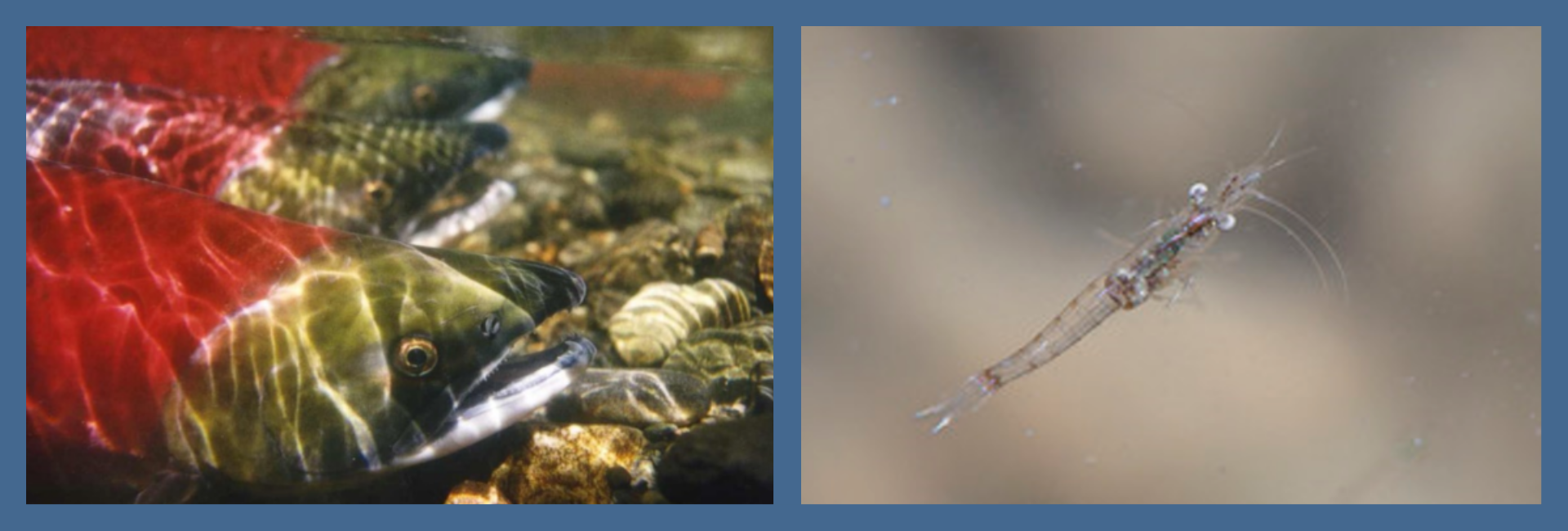We've started the rulemaking process to update our aquatic life toxics criteria. These criteria set limits for toxic chemicals so plants and animals that live in the water can thrive. Based on federal recommendations and feedback from residents, we're working to update our aquatic life toxics criteria to reflect new information about toxic chemicals.
Why are aquatic life toxics criteria important?
Aquatic life toxics criteria are part of our water quality standards — the rules that set the limits of pollution allowed in Washington's water. These criteria are designed to protect aquatic life (fish, plants, and invertebrates) from the effects of toxic chemicals in the water. We have separate criteria to protect humans from the effects of toxic chemicals in the water called the human health criteria, which we recently updated.
Octopus, lily pads, crabs, and rainbow trout are all included under the umbrella of "aquatic life."
Toxic chemicals include lead, mercury, chromium III, and other harmful chemicals. Above certain amounts, toxic chemicals in the water can harm aquatic life through either short-term (acute) effects, such as immediate death, and long-term (chronic) effects, such as changes in growth, reproduction, and survival. We use the criteria to set the limits to prevent both short and long-term consequences of toxic chemicals.
How are toxic limits determined?
When we set limits for toxic chemicals, we use data to look at how the most sensitive species in an ecosystem might respond to a certain level of the chemical in the water. We also look at the most sensitive life stage. For example, juvenile fish or eggs might be more sensitive to a certain toxic chemical than an adult fish, or vice versa. This approach helps ensure that all species and life stages are protected by the limits we set.
We set limits for toxic chemicals to protect sensitive species large and small, such as salmon
Over time, scientific research helps us gain a better understanding of how much of a certain chemical can be present in the water before it causes harm. We use new data and information to periodically update our water quality standards. We are now beginning a rulemaking to update the water quality criteria for toxic substances to reflect new information about these toxic chemicals.
Why do these criteria need updating?
We've been working on several updates to different parts of our water quality standards over the past several years. After we updated our Human Health Criteria for toxic chemicals in 2016, and then adopted more protective water quality criteria for young salmon, we're now ready to take on this important rulemaking to protect aquatic life from exposure to harmful chemicals.
We haven't updated the majority of our aquatic life toxics criteria since 1992 or earlier. Since then, new information has become available about toxic chemicals that will help us set levels to better protect aquatic life. This important update to our aquatic life toxics criteria is driven by both federal guidance and Washington residents’ feedback.
National guidance
The Environmental Protection Agency (EPA) periodically updates their recommended water quality criteria based on new information for each toxic chemical. States can incorporate those criteria into their own standards or use those recommendations as a baseline to set more protective levels based on local information.
Since our last update to the water quality standards for toxic chemicals, new chemicals have been added to EPA’s list of recommended aquatic life toxic criteria, and some chemicals on EPA’s list have levels that are more protective than those currently in Washington’s standards. We will use the list of federally recommended criteria to review our current standards. We will also look at any new information since EPA’s published recommendations to ensure our criteria reflect the most up-to-date science.
Feedback from Washington residents
Last year, during our 2021 Triennial Review process, we received feedback from Washington residents that updating the toxic chemical criteria is a priority. We also heard that commenters prefer we review and update the entire potential list of toxic chemicals in a single rulemaking.
Next steps
The first step in rulemaking is the development phase, which means we have not yet drafted a proposed rule. Throughout 2022 and part of 2023, we'll meet with Tribes, stakeholders, and government agencies about the potential rulemaking to seek their ideas, concerns, and alternative approaches.
We plan to propose draft rule language for comment in Fall 2023. At that time, we will host workshops and public hearings to seek more feedback. After evaluating the feedback we receive, we will make decisions on changes to the water quality standards for aquatic life toxics criteria.
To learn more about the rulemaking, visit our aquatic life toxics criteria rulemaking webpage.



